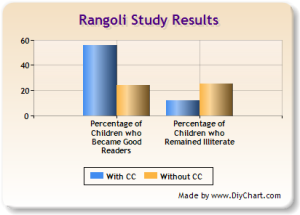If your children are watching television without the closed captioning option turned on, you are missing out on a wonderful opportunity to boost their reading ability. Let me explain.
In 2002, closed captioning was added to Rangoli, an Indian television program of Hindi film songs. Academic and researcher Brij Kothari looked at 13,000 early literate and illiterate people before the captioning was added in 2002 and five years after it was added. Kothari was looking to compare people who had a television and regularly watched Rangoli with people who had a television but did not regularly watch Rangoli. After five years of closed captioning, the results of the study showed its impact on literacy was profound:
The percentage of school children who became good readers more than doubled, and the percentage of school children who remained illiterate was cut in half with just one hour a week of exposure to closed captioning.
Closed captioning has been successful in raising the level of literacy elsewhere. A program titled AVAILLL, which has students watch captioned television and engage in accompanying activities, found students make large gains in reading in New Zealand and in Riverside, California. Jim Trelease, author of The Read Aloud Handbook, points out that children in Finland tend to have the highest reading scores in the world and also possibly the highest number of captioned television shows for children. In fact, Dr. Pasi Sahlberg, a Finnish Education Ministry official and author of several books, cites the country’s decision to require subtitles on foreign television shows as one of the three main reasons for Finland’s educational success.
The reason closed captioning has been so successful in helping emergent readers is it helps students learn to automatically recognize words. When we think of children learning to read, the image of a child “sounding out” a word often comes to mind. However, the majority of our reading comes from recognizing words with automaticity. LaBerge and Samuels suggested that when it comes to reading we have a limited cognitive capacity. Our brains can only do so many tasks at once. When we are able to recognize words instantly, the limited capacity of our attention is freed up to concentrate on comprehending what it is we are reading. Using less mental resources for decoding words allows us to spend more of our mental resources making meaning.
The use of closed captioning on television helps children increase the number of words they have in their mental word bank, allowing them to focus on understanding the text. One study found that seeing a word in captions four or five times in six minutes was enough exposure for second grade students to learn and retain the word up to 15 days later.
In addition to boosting the automaticity of younger, beginning readers, use of closed captioning has been shown to support the reading growth of struggling adolescent readers and children with learning disabilities. Special education students and below average readers in the Riverside AVAILLL study made reading gains of greater than two years in just a six-week period.
Considering the success rate of closed captioning in helping large numbers of young and struggling readers develop reading fluency in India and Finland, it would make sense for children’s shows here be required to include subtitles. It is an extremely cost-efficient way of boosting the country’s reading scores. Until that happens, however, parents who have the television on around their children would be well-advised to turn on closed captioning or subtitles.
None of this is to suggest the television is more valuable than a good book in a child’s hand. For helping children grow to love reading, there is no substitution for a home full of books and loving family members with whom to read them. But that’s another post.

